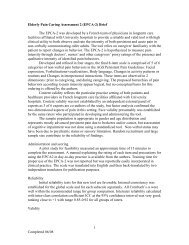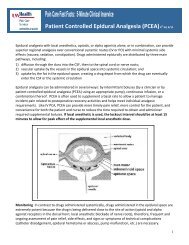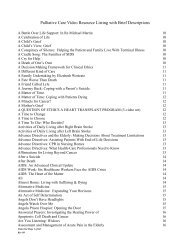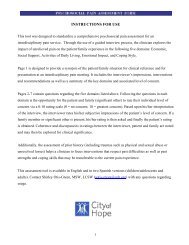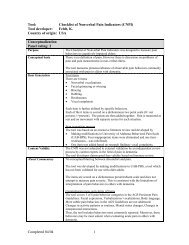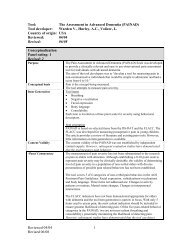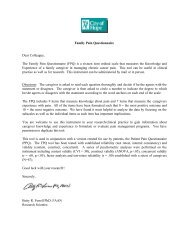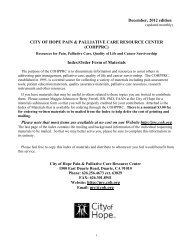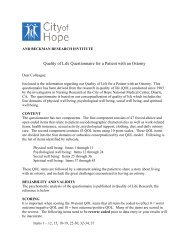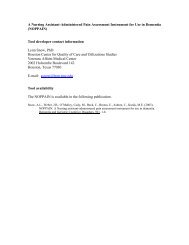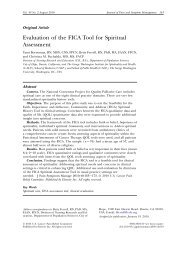Disability Distress Assessment Tool
Disability Distress Assessment Tool
Disability Distress Assessment Tool
Create successful ePaper yourself
Turn your PDF publications into a flip-book with our unique Google optimized e-Paper software.
v15<strong>Disability</strong><strong>Distress</strong> <strong>Assessment</strong> <strong>Tool</strong>Client’s name:DoB:Unit/ward:Your name:Gender:NHS No:Date completed:Names of others who helped complete this form:DisDAT isIntended to help identify distress cues in people who because of cognitive impairment or physical illness have severelylimited communication.Designed to describe a person’s usual content cues, thus enabling distress cues to be identified more clearly.NOT a scoring tool. It documents what many staff have done instinctively for many years thus providing a record againstwhich subtle changes can be compared. This information can be transferred with the client or patient to any environment.Only the first step. Once distress has been identified the usual clinical decisions have to be made by professionals.Meant to help you and your client or patient. It gives you more confidence in the observation skills you already havewhich in turn will help you improve the care of your client or patient.INSTRUCTIONS FOR USING DisDAT ARE ON THE BACK PAGESUMMARY OF SIGNS AND BEHAVIOURSAppearance when CONTENTAppearance when DISTRESSEDFaceEyesFaceEyesTongue/jawTongue/jawSkinSkinVocal signs when CONTENTSoundsSpeechVocal signs when DISTRESSEDSoundsSpeechHabits and mannerisms when CONTENTHabitsMannerismsComfortable distancePosture & observations when CONTENTPostureObservationsHabits and mannerisms when DISTRESSEDHabitsMannerismsComfortable distancePosture & observations when DISTRESSEDPostureObservationsKnown triggers of distress (write here any actions or situations that usually cause or worsen distress)DisDAT © 2006 Northumberland Tyne & Wear NHS Trust and St. Oswald's Hospice 1
<strong>Disability</strong><strong>Distress</strong> <strong>Assessment</strong> <strong>Tool</strong>Please take some time to think about and observe your client's appearance and behaviours when they areboth content and distressed, and describe these cues in the spaces given. We have listed words in eachsection to help you to describe your client or patient. You can circle the word or words that best describe thesigns and behaviours when your client or patient is content and when they are distressed. Document the cuesin each category and, if possible, give a fuller description in the spaces given. Your descriptions will provideyou with a clearer picture of your client’s ‘language’ of distress.COMMUNICATION LEVEL *This person is unable to show likes or dislikes Level 0This person is able to show that they like or don’t like something Level 1This person is able to show that they want more, or have had enough of something Level 2This person is able to show anticipation for their like or dislike of something Level 3This person is able to communicate detail, qualify, specify and/or indicate opinions Level 4* This is adapted from the Kidderminster Curriculum for Children and Adults with Profound Multiple Learning Difficulty (Jones, 1994, National Portage Association).FACIAL SIGNSAppearanceInformation / instructions Appearance when content Appearance when distressedRingthe words that bestdescribe the facialappearancePassive Laugh Smile FrownGrimace Startled FrightenedOther:Passive Laugh Smile FrownGrimace Startled FrightenedOther:Jaw movementInformation / instructions Movement when content Movement when distressedRingthe words that bestdescribe the jawmovementRelaxed Drooping GrindingBitingRigidOther:Relaxed Drooping GrindingBitingRigidOther:Appearance of eyesInformation / instructions Appearance when content Appearance when distressedRingthe words that bestdescribe theappearanceGood eye contact Little eye contactAvoiding eye contact Closed eyesStaring Sleepy eyesGood eye contact Little eye contactAvoiding eye contact Closed eyesStaring Sleepy eyes‘Smiling’ Winking Vacant‘Smiling’ Winking VacantTearsDilated pupilsTearsDilated pupilsOther:Other:SKIN APPEARANCEInformation / instructions Appearance when content Appearance when distressedRingthe words that bestdescribe theappearanceNormal Pale FlushedSweaty ClammyOther:Normal Pale FlushedSweaty ClammyOther:2 DisDAT © 2006 Northumberland Tyne & Wear NHS Trust and St. Oswald's Hospice
VOCAL SOUNDS (NB. The sounds that a person makes are not always linked to their feelings)Information / instructions Sounds when content Sounds when distressedRingthe words that bestdescribe the soundsWrite down commonly usedsounds (write it as it sounds;‘tizz’, ‘eeiow’, ‘tetetetete’):……………………………….………………………………………………………………Volume: high medium lowPitch: high medium lowDuration: short intermittent longDescription of sound / vocalisation:Cry out Wail Scream laughGroan / moan shout GurgleOther:Volume: high medium lowPitch: high medium lowDuration: short intermittentlongDescription of sound / vocalisation:Cry out Wail Scream laughGroan / moan shout GurgleOther:SPEECHInformation / instructions Words when content Words when distressedWrite down commonly usedwords and phrases. If no wordsare spoken, write NONERing the words which bestdescribe the speechClear Stutters Slurred UnclearMuttering Fast SlowLoud Soft WhisperOther:Clear Stutters Slurred UnclearMuttering Fast SlowLoud Soft WhisperOther:HABITS & MANNERISMSInformation / instructions Habits and mannerisms when content Habits and mannerisms when distressedWrite down the habits ormannerisms,eg. “Rocks when sitting”Write down any specialcomforters, possessions or toysthis person prefers.Please Ring the statementswhich best describe howcomfortable this person is withother people being physicallyclose byClose with strangersClose only if knownNo one allowed closeWithdraws if touchedClose with strangersClose only if knownNo one allowed closeWithdraws if touchedBODY POSTUREInformation / instructions Posture when content Posture when distressedRing the words that bestdescribe how thisperson sits and stands.Normal Rigid FloppyJerky Slumped RestlessTense Still Able to adjust positionLeans to sideWay of walking: Normal / AbnormalOther:Poor head controlNormal Rigid FloppyJerky Slumped RestlessTense Still Able to adjust positionLeans to sideWay of walking: Normal / AbnormalOther:BODY OBSERVATIONSInformation / instructions Observations when content Observations when distressedPoor head controlDescribe the pulse, breathing,sleep, appetite andusual eating pattern,eg. eats very quickly, takes along time with main course, eatspuddings quickly, “picky”.Pulse:Breathing:Sleep:Appetite:Eating pattern:Pulse:Breathing:Sleep:AppetiteEating pattern:DisDAT © 2006 Northumberland Tyne & Wear NHS Trust and St. Oswald's Hospice 3
[vl-ta] DisDAT Monitor Patient: Start month: Year:Q 1 Is the sign/behaviour of distress present? If No, score 0; if Yes, go to next questionQ 2 Is it moderately affecting on the day? If No, score 1; if Yes, go to next questionQ 3 Is it dominating the day? If No, score 2; if Yes, score 3Score based on PACA (Ellershaw J)Patient sign or behaviour of distress: (EXAMPLE):DATE 13 14 I 15 16 17 18 19 20 21 22 23 243 W I210DATEorTIME~~~arimeces25 26 27 28 29 30 30 1 2 3 4 5 6 7Patient sign or behaviour of distress:31---+-+--+--+--1--f--+-----11--+-+--+-+--+-+--+-+--f--+--+--+-+--+-+--+--1--f21---I---+--+---+-+---+--+---II----I--+--I---I--I--+---+--+---+--+--+---I--+--I--+---+-+--111---+--t--+---+--t----t---t---II---+--+--t--+--+-+---+--t----t---t--+--t--+--t--+---+--t----l0L-----'-_--'---_.l..-----L_...J...----'_--'----..JL--L_.l..----L._..L-----'-_..L---l._--'------'_--'---_L.----L._..L-----'-_-"------L_...J...-----'PaIr0patr_Paf lent Slgn or behaviour 0 f dllstress:321°Patient sign or behaviour of distress:31---t---t--+--+-+--+--t-----1L--+--+--+-+--+-+---+--t----t---t--I---+--+--t--+--+--t----l21--+---t--+--+-+--+-+-----1--+--+--+-+--+--+--+--t--f--+--1--+-+--+--+--+--t----110L-----'-_--'---_L.-----'-_..L---l._--'----..J_--'---_L.----L._..L-----'-_-"------L_--'------'_--'---_L.--L_.l..-----'-_..L-----'-_-'-----'PaIrP alen f t Slgn " or b e haviour 0 f di IS tress:3210TOTAL score
[v14] DisDAT Monitor Patient: Start month: Year:Document the daily frequency of each distress sign or behaviour with a v'Mark down the usual time each sign or behaviour lasts in minutesPatient sign or behaviour of distress: (EXAMPLE):DATE 13 14 15 16 17 18 19 20 21 22 23Frequency ././ ././ ./ ././ ./ ./ ./ ././ ./ ./ ./ ./ ./ ./ ./ ./How long? 10 12 6 8 5 5 2
~<strong>Disability</strong> <strong>Distress</strong> <strong>Assessment</strong> <strong>Tool</strong>(Monitoring <strong>Tool</strong>)Edinburgh University (Matt Hayes), Northgate Palliative Care Team and St. Oswald's HospiceClient's name: DoB: Page No:Unit/ward: Gender: NHS No:Please affix patientaddressograph herePlease complete at any times when you are concerned that the patient is distressedThis individual's signs and behaviours of contentment I distress are detailed on the first page of the DisDAT assessment sheetDateTimeIs PatientContent/<strong>Distress</strong>edPlease record observations of severity and duration ofdistress in these columns Action Taken OutcomeSigns of <strong>Distress</strong>Context of <strong>Distress</strong>© 2004 Northqate DisDAT 2




